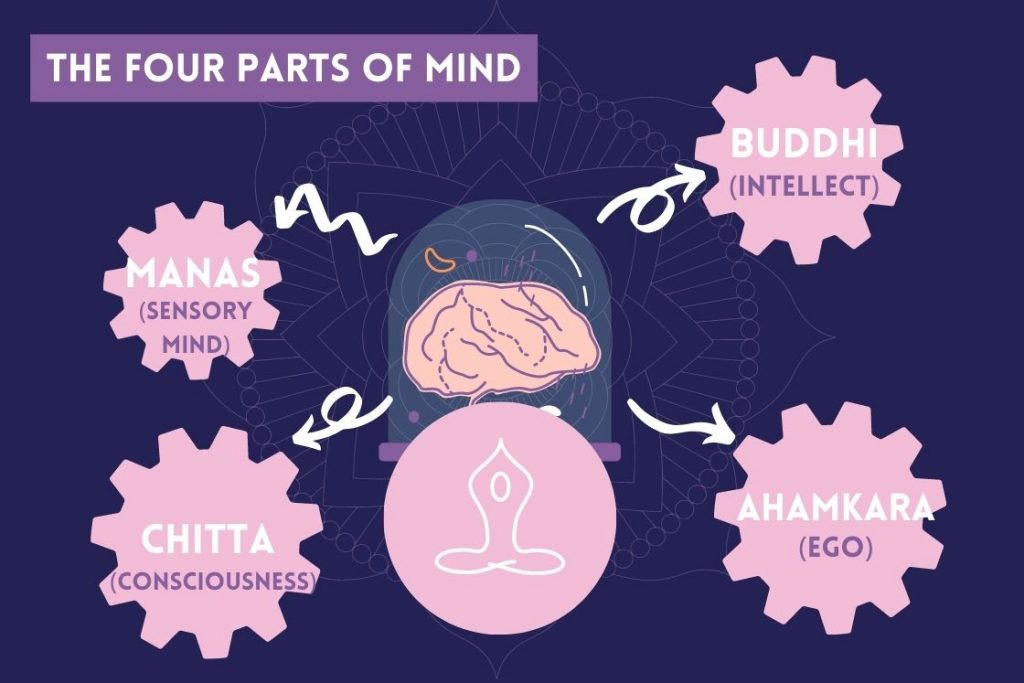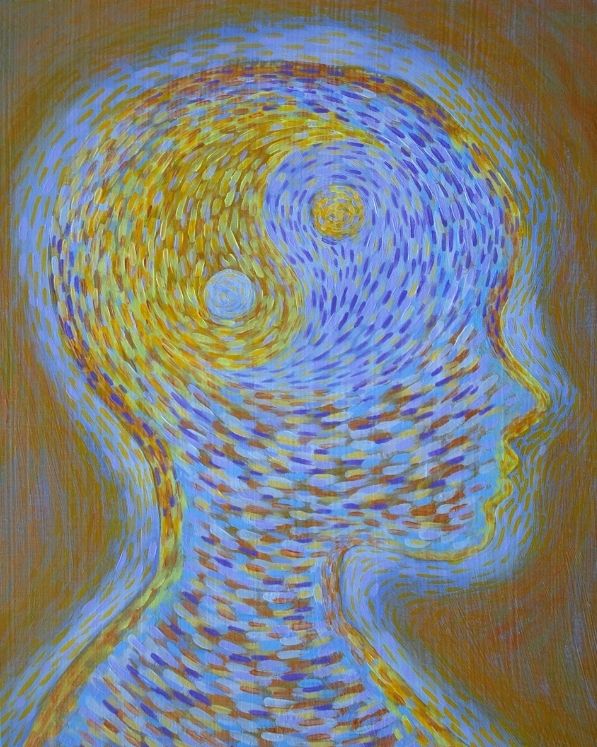- What is mind?
- 4 parts of mind
- Manas
- Chitta
- Ahamkara
- Buddhi
- Interaction among 4
- Yoga to regulate mind
- Going beyond mind

From perceiving the career opportunities to feeling proud of achieving them and from making a decision between right and easy to not being able to forget a painful memory, is all an impression of our mind. The mind makes up the experiences and gives meaning to our life.
But as a result of uncountable mental impressions, we are restless. It is the mind’s tendency to fall for every occurrence and ultimately make us live according to its rules. However, the purpose of yoga is to reverse this conditioning and regulate the monkey mind to let us relieve the pain & miseries of the world to lead a peaceful life.
As beautifully said in yoga sutras itself,
“Yoga means stillness of mind and freedom from oscillations of various mental processes.”
~ Sage Patanjali, Father of Yoga
What is Mind According to Yoga?
The very definition of yoga talks about silencing the mind. Sage Patanjali defines yoga as a practice to quieten the mind and the fluctuations generated by it. This means that yoga cannot be achieved without understanding, discriminating, and coordinating the mind.
In yoga, the mind is not seen as synonymous with the brain which has a certain space in the physical body and controls logical operations. The yogic concept of mind combines all the conscious and unconscious activity of a person. It includes our thoughts, feelings, memories, beliefs and even the ego that makes us realize our existence.
When the mind is conditioned, it supports the body through every experience and condition. The mind is the source of pleasure and pain. It is the mind, which can also lead us to the higher stages of Samadhi. Sage Patanjali emphasized the paramount importance of the mind. That’s why he has discussed the ways to discipline the mind (Yamas and Niyamas) even before he explained the physical postures, meditation and breathing exercises.
What makes the mind “MIND”?

Most western theories look at the mind as one single unit. But in yogic understanding, there are 16 dimensions of a human mind, categorized into 4 parts. These categories are Manas, Chitta, Ahamkara, and Buddhi – the four parts of the mind to harness through yogic practice.
These four parts of the mind work in coordination with each other to let us experience the world. Imagine them spokes on a wheel. The wheel rotates to give us perceptions of reality, whereas the core (mind) remains still. This is the ideal condition of yoga, an undistracted, still core!
1. Manas – Which keeps the memory
Manas, according to yoga, is the basic part of the mind, associated with getting the external information in the system. Its function is to understand and decide the important and necessary sensory information to pass to the internal system. Manas has the ability to question and doubt, which sometimes can lead to mental difficulties.
Generally considered similar to the brain in its function, Manas is a controller of the 5 sensory organs and 5 organs of action. It guides the mind to various directions that are important.
However, Manas does not have the authority to take the final decision, it relies largely on the mechanisms of Buddhi. Since it is in charge of the sensory organs, Manas is easy prey for our desires, wishes, attractions, and aversions.
2. Chitta – Which makes us aware
You must have heard terms such as ‘Supreme consciousness’ or ‘Pure consciousness’.
Chitta is the most important part of our mind which is related to consciousness. Think of the mind as a magnetic plate. Now, whatever comes and goes off this plate, which makes us aware of those objects (thoughts, memories, feelings, sensations, and environments) is Chitta actually.
Chitta in yoga is that property of the mind which makes us aware of the objects, whether we are in a waking or sleeping state (consciously or unconsciously).
It’s said, we all are part of ‘Universal’ or ‘Supreme consciousness’ initially when we take birth on this earth, but as ego (Ahamkara) starts evolving in our mind, ‘Individual consciousness’ slowly start taking place of that ‘Universal consciousness’. Yoga, by various means of practice, symbolizes the union of ‘Individual consciousness’ with ‘Universal consciousness’. The consciousness of an individual being is ‘soul’ (Atma) and its union with the universal one makes it ‘supreme soul’ (Paramatma).
3. Ahamkara – Which provides sense of Identity
Ahamkara can be defined as the person’s ego or the sense of ‘I-ness’. However, it is much more than ego. Ahamkara gives identity to the individual and makes him or her unique. Although it is a separate and special characteristic to the individual, Ahamkara often leads to feelings of alienation, pain, or loneliness.
If Ahankara dominates, your mind can only understand and make decisions only in its contexts. It also affects Manas and compels it to act in reference to one’s own individuality. Ahamkara takes in Chitta as a partner to bring the stored memories associated with the person’s ego. It does not let the intellect see the irrationality of those memories, thereby clouding Buddhi.
However, it is necessary to understand that Ahamkara is not always negative. When a person aims to succeed in yoga, he or she is in need of the determination of “I can do it”. It is largely offered by the person’s Ahamkara. A certain amount of Ahamkara is good for upliftment. It is the job of Buddhi to not let it go out of control and lead to separation and ego.
4. Buddhi – Which work intellectually
The word Buddhi is derived from ‘Budh’, which means awakening or awakened. It is a higher state of the mind, closer to wisdom. Buddhi is the discriminating function that judges, decides, and makes cognitive differentiation.
In the ideal condition, Buddhi is the decision maker faculty of the mind. But it can only take wise and fruitful decisions if it operates to its full capacity without being clouded by Manas, Chitta, and Ahamkara. If Buddhi functions properly, the Manas takes its commands and acts accordingly.
Buddhi is a layer of the mind, closest to wisdom. When it is unclouded completely, it encourages all the other layers to behave in rhythm. Buddhi is the determinant of finding the higher truth. If we look at it closely, we may see that even if it acts as a tool to deepen one’s meditation to understand the universe, it is Buddhi that created the universe in the first place.
Interaction Among Manas, Chitta, Ahamkara, and Buddhi

Imbalance in the four parts of the mind is the major reason for our disturbed and restless minds. Manas is the controller of the sense and action organs. But if it is misguided by Chitta’s impressions, it tends to surrender to desires. Manas can only control desires if Chitta, Ahamkara, and Buddhi are behaving properly.
Chitta’s function is guided by egoistic thoughts produced by Ahamkara. It is unable to perform if the memory storage is only bringing up the sad and painful thoughts which must have heard the person’s identity in the past.
The association between Ahamkara and the memories of Chitta are the major cause of mental problems. The memories stored in Chitta get colored by the ‘I-ness’ of Ahamkara and fight for attention from Buddhi. If Buddhi is not operating logically, these colored impressions drive Manas to take actions that are neither healthy nor good for the mind.
Only Buddhi can discriminate between right and wrong and command all others to make their decisions right. It can understand the false identity Ahamkara is holding on to and convince Ahamkara of dropping it.
When Ahamkara surrenders the ego, Chitta rights itself by showing the positive latent impressions of the mind. And when the Chitta is purified, Manas is not anymore, a prey of desires. For this, yoga emphasizes unclouding the Buddhi to make other aspects of the mind to function healthily. This is called regulating or balancing the core by Patanjali.
Yoga to Regulate the Mind
Sage Patanjali talks about the mind as a determinant of what kind of life we live. The mind, constituting its 4 parts, is responsible for our gross to subtle aspects of being and should be regulated to ensure our healthy and sound existence. It is possible with yoga and its principles.
Here are some yoga practices that can help you balance Manas, Chitta, Ahamkara, and Buddhi and clear your way to higher understanding.
1. Be mindful of Your Senses and Actions
The first stage to regulate the mind is to observe the workings of Manas. By observing the activities of Manas like your sensory inputs and actions, you can understand how it supervises and orders them to get what they want or behave in the way that is most pleasing.
Being mindful of your senses and actions can make you understand that Manas is playing with them, which can get you in mental trouble. To bring the fluctuations of Manas in control, you can practice the personal and social disciplines (Yamas and Niyams). They can help you get rid of our loose senses and regulate our actions to clear the way to peace.
2. Witness Your Thoughts
Observing what comes and what goes is an important exercise to cultivate the workings of Chitta. When you are aware of your emotions, thoughts, what your mind is processing for a long time, or which memory your mind is getting stuck at, you can better regulate Chitta.
This is possible through deep breathing and meditation. When the mind is focused on one single function, the breathing, there is a less chance it gets distracted. Of course, it is a process which takes consistent practice. But if you inculcate the habit of performing your breathing and meditations mindfully, you can attenuate Chitta from negative to positive.
3. Surrender to the Higher Power
Patanjali describes surrendering to the higher power as Ishvara Pranidhana. Surrendering does not mean forgetting yourselves or detaching from your immediate environment. But it means to get rid of all the wrongful ideas about oneself.
This can be achieved through the practice of worship, prayers, believing, and respecting the power of the Supreme. Yoga recommends the practice of Ishvara Pranidhana to drop off the ego from a person so he or she can uplevel on the spiritual path.
Dissociating with the inaccurate identities and accepting there is a truth beyond our own identity is an exercise to coordinate Ahamkara functions with the system.
4. Let Go of the False Associations
Falsely identifying ourselves with our body, mind, achievements, pleasures keep the Buddhi clouded. And until Buddhi is clouded, it cannot produce healthy outcomes. The strength of Buddhi is its discriminatory power, the essence of which lies in letting go of the false associations.
Practice of breathing exercises, meditation helps understand that there is more to ourselves than our pleasures, desires, pains, and sufferings. It guides our way to the right identification of our true nature.
Unclouding Buddhi is the most important exercise as Buddhi plays a key role in the functioning of all other layers. In the presence of clear and logical decisions by Buddhi, Ahamkara drops off, Chitta gets colored with goodness, and Manas act the way beneficial for a person’s peaceful life.
Going Beyond the Mind

From all the chatter above, you must have understood the basic functions of the mind as a whole. It has direct control over breath, senses, and the body. It influences the senses and guides them to act. It has the ability to desire things for itself that may or may not create mental troubles. The mind performs these operations through its four layers.
The purpose of coordinating all these layers of the mind is to lead to peaceful and productive life away from miseries. Yoga recommends exercises like spiritual practices, breathing, and disciplines to train the mind and teach it to run in a way that is less miserable.
However, yoga aims at an even bigger goal. It is to transcend the mind. It is to help the mind remember that the impressions caused by it are not real and the truth is beyond that.
Yogic practices help us understand that the Supreme Reality is actually the fundamental aspect of our being and not the stories colored by the mind. This decoloring of mind’s stories takes place when a person performs yoga and sticks to it regularly.
Final Thoughts
The mind with its four aspects operates on all levels of consciousness. It is active when we are awake, asleep, and in a dream state. The impressions of the mind influence our daily activities to a great extent. But if anything goes wrong, we simply blame the mind and create more impressions to get rid of the wrongdoing by forcing us to forget it.
Yoga offers a healthier way to regulate these impressions. It recommends the practitioners to understand and observe the four layers of the mind through yogic practices like disciplines, breathing, and meditation so they can avoid the wrongful impressions taking a dominant place in their minds. Yoga is a way of not forgetting the wrongdoing and moving on but undoing the wrong by doing it right at its root!





Good read eventhough I read it before.
Hi Ashish,
Excellent explanation of 4 parts of mind along with greta practices to correct each aspect. Enjoyed learning from your article. Much gratitude
Rashmi